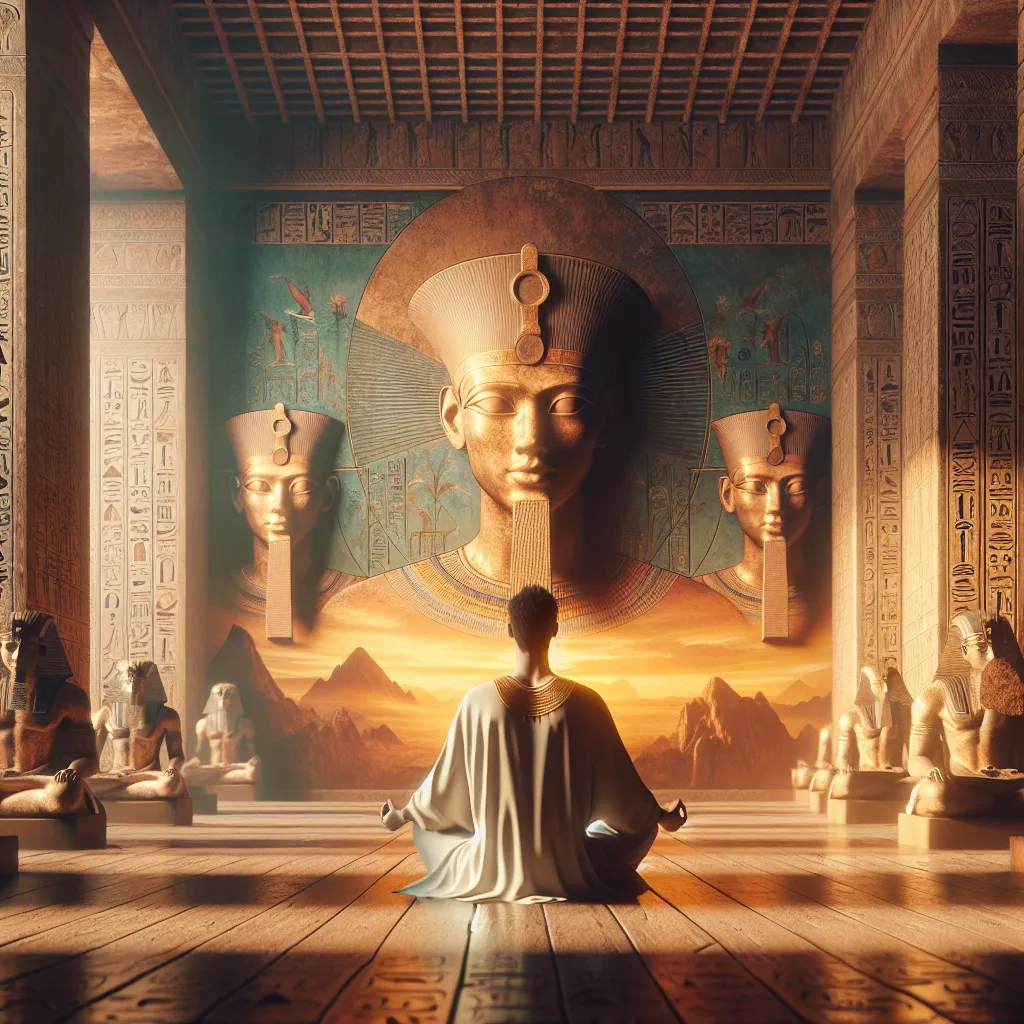
- Published on
- Authors

- Name
- You
The Role of Breath in Egyptian Spirituality: Connecting with the Divine
Introduction
In the realm of ancient Egyptian spirituality, breath was revered as a potent force bridging the mortal and divine realms. The Egyptians, both practical and mystical in their worldview, perceived breathing as more than a mere physiological function—it was a sacred act imbued with spiritual significance. This article delves into the profound role of breath in Egyptian spiritual practices and its use as a conduit for connecting with the divine.
Breath as Life Force
The Essence of Breath: "Shu"
In Egyptian mythology, breath was often associated with the god Shu, the divine personification of air. Shu was seen as the lifebringer, separating the sky from the earth and enabling life to flourish. The Egyptians considered the act of breathing as drawing in Shu's essence, thus seeing breath as the fundamental life force (or ka), integral to existence.
Hieroglyphic Symbolism
The Egyptian hieroglyphic symbol for breath (𓏠) carries a deeper philosophical meaning, representing not just air but also the soul’s vitality. Hieroglyphs involving breath often adorned tomb walls, symbolizing the eternal life force that sustains both the living and the spirits of the deceased.
Breath in Ritual Practice
Meditation and Pranayama
Meditative practices involving controlled breathing, akin to what modern-day practices refer to as pranayama, played a crucial role in spiritual rituals. Egyptian priests and initiates in the Mysteries of Isis and Osiris undertook specific breathwork to attain altered states of consciousness and commune with the gods.
“To breathe, to live, is to partake in the essence of the divine.” – Ancient Egyptian Proverb
Ritual Example: The Breath of Osiris
In rituals dedicated to Osiris, participants performed breath exercises to summon his presence. Deep inhalations through the nose, visualizing the intake of divine energy, followed by slow exhalations through the mouth, symbolized releasing worldly burdens. Such practices aimed to establish an intimate connection with Osiris’ resurrecting power.
| Step | Description |
|---|---|
| Preparation | Quiet setting, symbolic cleansing (e.g., washing hands) |
| Inhalation | Deep nasal breaths, visualizing divine energy flowing in |
| Exhalation | Slow mouth breaths, focusing on releasing negative energies |
| Repetition | Cycle repeated multiple times to deepen the meditative state and engagement with the divine |
Scientific Correlation: Breath and Altered States
Modern Perspectives
Modern science has begun to explore the physiological impacts of controlled breathing on the brain and body. Techniques similar to ancient practices have shown:
- Reduced Stress Levels: Deep breathing activates the parasympathetic nervous system, reducing stress and inducing calm.
- Enhanced Focus and Clarity: Increased oxygen intake enhances cognitive function and mental clarity, facilitating deeper meditative states.
Bridging Ancient Wisdom and Modern Science
The practices of ancient Egyptians in controlled, ritualistic breathing correspond to modern understandings of breathwork’s benefits. This fusion of advanced science and mystical wisdom offers an enriched perspective on the inherent power of breath.
Conclusion
The ancient Egyptians understood breath as a spiritual bridge, a sacred conduit connecting humanity with the divine. Their practices, deeply interwoven with their mythology and theological understanding, reflect a sophisticated appreciation of breath’s significance. Today, by blending the ancients' mystical wisdom with modern scientific insights, we can rediscover the transformative potential of breath in our own spiritual journeys.
Explore Further
To delve deeper into the mystical role of breath in various spiritual traditions, consider reading:
- "The Science of Breath: The Profound Influence of Ancient Practices on Modern Well-being" by Dr. Lillian Smith
- "Mystics and Meditators: Ancient Techniques for Contemporary Practitioners" by John M. Harrison
By embracing both scientific and mystical perspectives, we continue to honor the ancient practices while enriching our modern understanding of spiritual life.
